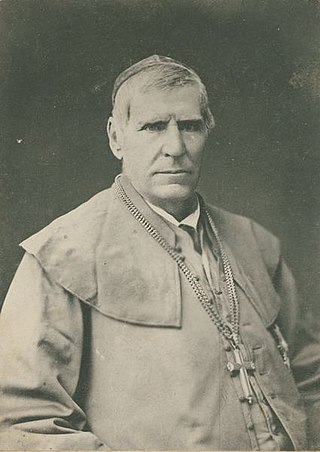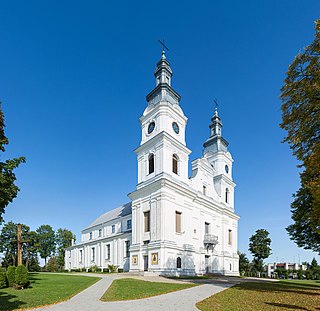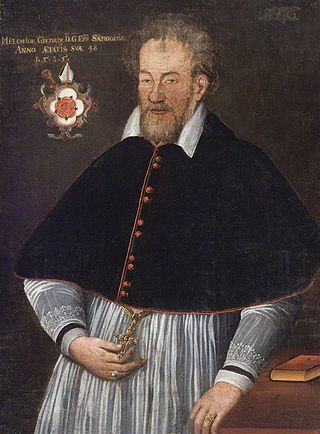
Samogitia or Žemaitija is one of the five cultural regions of Lithuania and formerly one of the two core administrative divisions of the Grand Duchy of Lithuania alongside Lithuania proper. Žemaitija is located in northwestern Lithuania. Its largest city is Šiauliai. Žemaitija has a long and distinct cultural history, reflected in the existence of the Samogitian language.

The Duchy of Samogitia was an administrative unit of the Grand Duchy of Lithuania from 1422. Between 1422 and 1441 it was known as the Eldership of Samogitia. Since the 1540s the Grand Duke of Lithuania also held the title of Duke of Samogitia, although the actual ruler of the province, responsible to the Grand Duke, was known as the General Elder of Samogitia who was self-elected by the Samogitian nobility.

Motiejus Kazimieras Valančius was a Catholic Bishop of Samogitia, historian and one of the best known Lithuanian/Samogitian writers of the 19th century.

Kražiai is a historic town in Lithuania, located in the Kelmė district municipality, between Varniai (32 km) and Raseiniai (44 km), on the Kražantė River. The old town of Kražiai is an archeological and urban monument.

Varniai is a city in the Telšiai County, western Lithuania. In the Middle Ages the city was known as Medininkai.

Kaunas Priest Seminary is the largest seminary in Lithuania serving the Roman Catholic Archdiocese of Kaunas. It is part of the Faculty of Theology of Vytautas Magnus University. Its current rector is Aurelijus Žukauskas. As of 2007, the seminary had 35 students. It traces its history to 1622.

Cathedral Basilica of apostles St. Peter and St. Paul of Kaunas is a Roman Catholic cathedral basilica in Kaunas, Lithuania.

The Metropolitan Archdiocese of Kaunas is a Latin Church ecclesiastical territory or archdiocese of the Catholic Church in Lithuania. The episcopal see is in Kaunas, the second-largest city in Lithuania. The archdiocese's motherchurch and cathedral is Kaunas Cathedral Basilica; it is also home to a Minor Basilica in a town of Šiluva, in the region of Samogitia.

Žemaičių Kalvarija is a town in Plungė district municipality, Lithuania. It is known as a major site for Catholic pilgrimage.

The Roman Catholic Diocese of Telšiai is a suffragan Latin diocese in the ecclesiastical province of the Metropolitan of Kaunas, one of two in Lithuania.

Merkelis Giedraitis was Bishop of Samogitia from 1576 to 1609. Educated at Protestant universities in the Duchy of Prussia and Germany, he actively combated the Reformation implementing resolutions of the Council of Trent in Samogitia. Born into the princely Giedraičiai family, he inherited a much neglected diocese that was reduced to only about 20 priests. He became known for his devotion and work to end clerical abuses, strengthen churches and schools, and increase the number of priests. Giedraitis invited the Jesuits to Kražiai where the Kražiai College was established already after his death and the Bernadines to Kretinga where they established the first monastery in Samogitia. He sponsored Mikalojus Daukša, who translated and published Catechism (1595) and Postil (1599) in the Lithuanian language—the first Lithuanian books printed within the Grand Duchy of Lithuania. He also supported Maciej Stryjkowski, author of the first printed history of Lithuania. In recognition of his efforts, Giedraitis is often referred to as the second baptist of Samogitia.
The Brotherhood of Saint Roch was a Catholic religious institute in the Grand Duchy of Lithuania. Named after Saint Roch, the brotherhood was founded in 1705 by the Franciscan tertiary Jonas Jarolavičius in Vilnius.

St. Peter and St. Paul's Church is a Roman Catholic church in Varniai, Lithuania. Until 1864 the church was the cathedral of Samogitian diocese and the seat of Bishops of Samogitia.
Kajetonas Rokas Nezabitauskis-Zabitis or Kajetan Roch Niezabitowski was a Lithuanian patriot promoting the use of the Lithuanian language during the early stages of the Lithuanian National Revival. He was the half-brother of the priest Kiprijonas Nezabitauskis. After law studies at Vilnius University, he moved to Warsaw where he worked at the state censorship office until retirement in 1857. His main work is a Lithuanian primer published in 1824. It was the first illustrated primer as well as the first to include Lithuanian proverbs. It was accompanied by the first Lithuanian bibliography – a list of 73 Lithuanian-language books and manuscripts between 1557 and 1824. Between 1835 and 1850, he edited the Polish calendar Kalendarz powszechny.
Jurgis Petkūnas was a Bishop of Samogitia from 1567 to 1574. He received medical education in universities in Germany and Italy. Despite his lack of theological education, Petkūnas was confirmed as bishop in November 1567. He inherited a neglected diocese that had only about 20 priests and faced competition from the Protestants. He was the first Samogitian bishop charged with implementing the Counter-Reformation decisions of the Council of Trent.

The Samogitian Diocese Museum is a museum dedicated to the former Diocese of Samogitia. Established in 1999, the museum is located in the building of the former Varniai Priest Seminary which was relocated to Kaunas after the failed Uprising of 1863. The museum is a branch of the Samogitian Museum Alka based in Telšiai.

St. Alexander's church in Varniai is the oldest church in Samogitia.
The Samogitian Division was a division-size unit of rebels of the Grand Duchy of Lithuania during the Kościuszko Uprising in 1794.
Vincentas Šliogeris – Lithuanian priest, poet and translator. He distributed prohibited Lithuanian press against the Lithuanian press ban.

Mečislovas Leonardas Paliulionis was a Roman Catholic bishop of the Diocese of Samogitia.
















